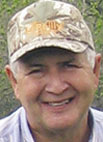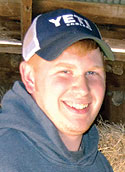
Jerry Floyd is a man who knows what he likes. Living on his 120-acre Webster County farm, near Marshfield, Mo., with his wife, Doris, Jerry was a dairy farmer until about 12 years ago. Since then he has been raising steers.
“I like Holstein steers. Back then they were easy to get. They grow faster than the beef breeds, and they’re a little hardier. But the last couple of years it’s been a little harder to get the Holsteins because so many dairy farmers have went out,” he said.
That has left Jerry switching over and getting the beef breeds now, but he still buys what Holsteins he can. "But it seems like they are really hard to come by," he said.
Jerry starts forming his herd in December. “I try to buy about 300 pound weight, and that puts me at a real good age at grass time.” By acquiring his steers in December, Jerry believes they get over the initial shock better. Then in February or March he vaccinates.
“I have all vaccinations, worming, blackleg, five-way respiratory, all that stuff done to them, so when grass comes in April they hit the ground growing, and they do. They do good for me that way. I usually run them till October then sell them,” Jerry said.
“As a rule,” he said, “I just worm them in the spring.” But his steers do get a second round of blackleg, a grass tetany shot and a respiratory. "I do that every six months.”
Another way Jerry tries to prevent disease is by purchasing his steers directly from farmers. “I have some around Lebanon that I buy from. But, I’m going to contradict myself. I try to put a bunch together, and if I’m short five or ten, I will sometimes go to the Buffalo Sale Barn and buy some.” But he makes every effort to purchase his cattle straight from the farmer.
Jerry does not keep a steady number of cattle. “Some years I’ll run 60 head, and some years I’ll run 30. What I do is buy two different bunches of different sizes. The reason I didn’t do it this year; with the way things looked in December, January and February, I thought I’d just try 30 head this year and not get that second bunch.” He went on to explain, “This bunch I have now will be sold in October. If I had another bunch, I’d carry them over and sell them in the spring. But with the economic downturn, I don’t want to get caught with too many at one time.”
Most of Jerry’s steers are Holsteins, but he has some Angus and some Charolais-mixed.
Jerry prefers raising steers over keeping beef cattle. He said, “I’ve had cattle all my life. There is money to be made in beef cattle, not as much as there was, but there is money to be made. But with beef cattle, you lose a calf, have a cow that won’t breed, and a few things like that and you’re losing all that time. Whereas, an old steer, he’s gaining every day out there and every time he gains it’s making you money.” He conceded that a steer will die once in a while, but, he explained, it seems like with beef cattle you’re always going to have problems.
Raising hay on his bottom land, Jerry sells 150 to 200 bales a year. He has someone who contracts to bale the hay. “He takes part of the hay and does my baling for me,” Jerry said.
The high cost of fertilizer has sent many farmers searching for an alternative. Jerry said, “I went to a different thing this year; liquid fertilizer. It’s the first time I’ve done it. I just put it on last week. A neighbor and I decided to try it this year. If it works out, it’s going to be good because it’s going to be half the price of the granules. It’s supposed to be just as good, so we’ll find out what it does.”
For Jerry Floyd, having cattle is “just a way of life. When the cattle are on the side of the hill grazing, that’s the prettiest picture I can imagine.” Jerry owns the farm he is living on, and it's soon to be 40 years there.
Jerry said the greatest benefit of having cattle is self-satisfaction. "Some people like a big bass boat in their driveway. I like a bunch of cattle on the grass.”







